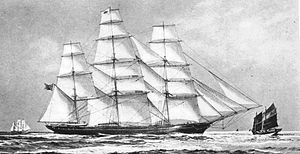Sir Lancelot (clipper)
 Sir Lancelot
| |
| History | |
|---|---|
| Builder | Robert Steele & Company, Greenock |
| Launched | 1865 |
| Owner | Visram Ibrahim |
| Acquired | 1886 |
| Notes | India-Mauritius trade |
| Acquired | 1895 |
| Out of service | 1895 |
| General characteristics | |
| Class and type | Composite clipper |
| Tonnage | 886 NRT |
| Length | 197.6 ft (60.2 m)[1]: 164 |
| Beam | 33.7 ft (10.3 m)[1]: 164 |
| Depth | 21 ft (6.4 m)[1]: 164 |
| Sail plan |
|
Sir Lancelot was a clipper ship which sailed in the China trade and the India-Mauritius trade.
Built in 1865 by Robert Steele & Company, Greenock, Sir Lancelot was "a beautiful tea clipper"[2] called the "Yacht of the Indian Ocean".
There is some discussion as to whether Sir Lancelot was an exact sister ship of Ariel. This is felt unlikely, as the two ships were built for different owners, and Sir Lancelot did not display the tenderness aft that Ariel displayed. But it is clear that the two ships were very similar.[1]: 133–134, 152, 163–166
Sir Lancelot was composite-built, planked with elm below the bilge and teak above that. She carried 100 tons of permanent iron ballast.[1]: 164, 166
Sir Lancelot was typical of all of Steele's ships, celebrated for their beauty of model, perfection of build, and superb finish.[2] In the poem By the Old Pagoda Anchorage, she is referred to as "Sir Lancelot of a hundred famous fights with wind and wave".[3]
Voyages and races
Captain Richard 'Dickie' Robinson of Workington was persuaded to leave the Fiery Cross to take charge of the new clipper. In a letter to naval historian Basil Lubbock, Sir Lancelot's owner John McCunn wrote; "Robinson was the best man I ever had in any ship and knew he got the best racing results out of Sir Lancelot".[4]
In the Clipper Race of 1869, Robinson and Sir Lancelot established a new record between China and London. She arrived in Hong Kong on 10 January 1869 and undertook a number of "intermediate" passages to Bangkok, Saigon and Yokohama (probably carrying rice), arriving in Foochow on 20 June. This made her late loading tea; 7 ships left Foochow before her, the first being Ariel and Leander on 1 July. The Thermopylae got away on 3 July. Previously, a further 7 ships had already left other ports in China during June.[1]: 165
Sir Lancelot sailed at 7.00 am on 17 July and passed Anjer on 7 August. By 1 September, Cape Agulhas bore North East, 12 miles. St Helena was passed on 11 September and The Lizard 10 October. She was at Gravesend at 2.00 pm on 13 October and docked on 14 October. This was a total passage time of 89 days.[1]: 165
In the same "tea season", the closest time was that of Thermopylae at 91 days. In other years, there was one passage from Hong Kong to London made during the more favourable north-east monsoon, also of 89 days, by the Lothair in 1873/74. There are 3 passages of 85, 87, and 88 days from China to Liverpool (a slightly shorter distance) - all during the north-east monsoon. The consensus view, taking into account the season and the distance, is that Sir Lancelot's 1869 passage was the fastest from China to England.[1]: 165 [5]
Commander Dickie Robinson left Sir Lancelot because of his wife's sudden death. Under Captain Edmonds, Sir Lancelot went out to Hong Kong in 97 days and came home from Fuzhou in 104 days. But with the opening of the Suez Canal in 1869, races between the clippers lost their real significance and ships concentrated on passages to New York.[4]
Captain Murdo Stewart MacDonald took command of Sir Lancelot in 1882.[6] She took sugar and rice from Mauritius to the Indian coast or the Gulfs and salt to Calcutta or Rangoon. She took six cargoes a year, when speed meant money, and when almost every passage saw the breaking of a record.[7]
In 1886 Sir Lancelot was bought by the Parsee merchant Visram Ibrahim and C.W.Brebner took command. Captain Brebner survived four cyclones in Sir Lancelot before she was sold to Persian owners in 1895.[8]
Sir Lancelot was lost in the Bay of Bengal on 1 October 1895 during a cyclone near Sand Heads, Calcutta whilst on passage from the Red Sea with a cargo of salt bound for Calcutta.[8]
Ship's model
References
- ^ a b c d e f g h i j MacGregor, David R. (1983). The Tea Clippers, Their History and Development 1833–1875. Conway Maritime Press Limited. ISBN 0 85177 256 0.
- ^ a b http://www.flipkart.com/colonial-clippers-basil-lubbock/1417964162-box3fzgz0e#previewbook
- ^ http://oldpoetry.com/opoem/52113-Cicely-Fox-Smith-By-The-Old-Pagoda-Anchorage--1924-
- ^ a b http://www.sunnygovan.com/PLACES/Clyde/SirLancelot.html
- ^ Shewan, Andrew (1973) [1927]. The Great Days of Sail. Conway Maritime Press Limited. ISBN 0 85177 699 X.
- ^ "Stornoway Gazette". Archived from the original on 29 June 2009. Retrieved 23 July 2010.
- ^ Final Port of Last Sea Baron
- ^ a b [1]
